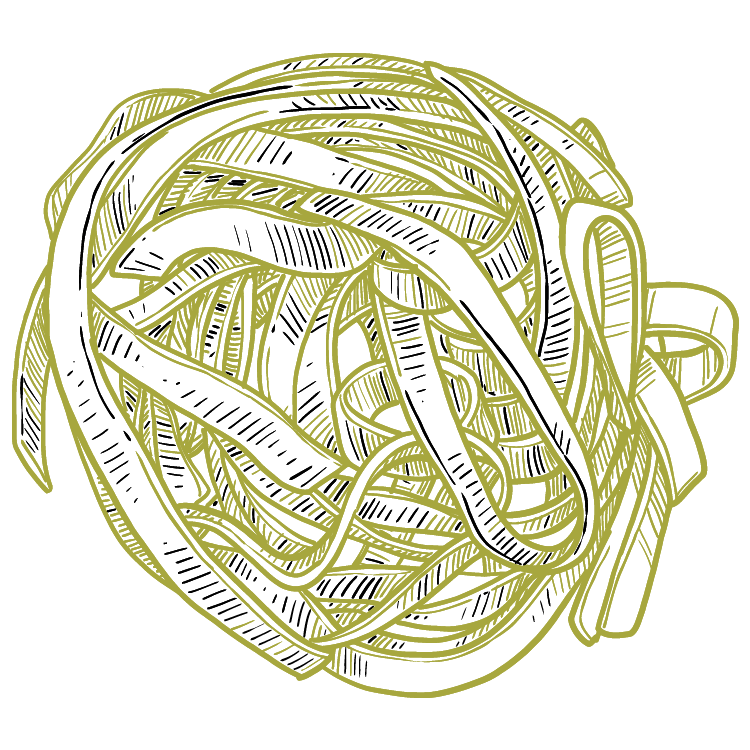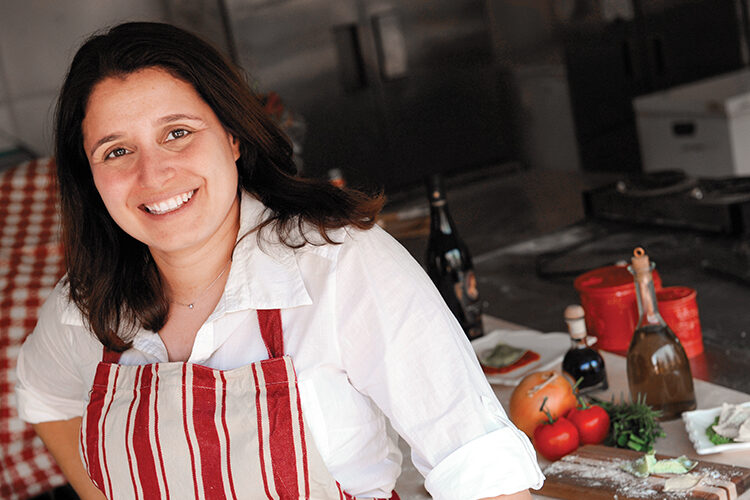At Melina’s Fresh Pasta in Durham, N.C., the smell of lemon zest and the salty kick of cheese fills the air. From fettuccine to gnocchi, each parcel of pasta is made from scratch, then packed up and sold for the community to enjoy at home. Owner Carmella Alvaro ’98 is the mastermind behind the counter, adding new creations, like Super Bowl buffalo chicken ravioli, to the menu periodically.
Coming up with new recipes is no new thing for Alvaro, so when she was approached by Rockridge Press to turn her recipes into a cookbook, Alvaro knew it was the perfect time to share her penchant for pasta with the greater food community. “I’m not a trained chef, so it probably is the food I know the most about,” she says.
Alvaro first became fascinated with the art of pasta making on a trip to Bologna, Italy, in September 2010. The impetus for the vacation: a boring sales job. She needed a break, and learning a new skill sounded freeing. She’s also first-generation Italian-American and had a desire to connect more with her heritage. So, she took a one-on-one workshop in northern Italy. The skill stuck; when she returned home to Durham, she began making pasta by hand, selling it at the local farmer’s market. “I was having fun, and I could do it on the side with my schedule,” Alvaro says. Shoppers ate it up, and she was soon selling out of her products.
Once she saw just how strong local craving for pasta was, Alvaro adjusted her schedule to devote even more time to pasta making, going part time at her day job, and then, when that became unsustainable, she made food her full-time gig, and Melina’s Fresh Pasta was born. A few of Alvaro’s Colgate friends and roommates helped get the business moving, providing pro bono marketing and help in the kitchen.
Though Alvaro uses machines to assist in the production process at her shop, the recipes in Authentic Homemade Pasta (Rockridge Press, 2020) are designed for novice cooks, no fancy tools needed. “A lot of people think [at the shop] I’m a little Italian nonna with a rolling pin and am kneading the dough just like it is in the book … it was really fun to go back to making it by hand for the cookbook,” she says. The book includes recipes for a variety of pasta types, including options like cut and hand shaped, plus sauce and filling recommendations. Her advice for home cooks: “Pasta is so forgiving. Just give it a shot, and you’ll get the feel over time.”
Writing a cookbook during a pandemic, while owning a food business, wasn’t easy for Alvaro. But hearing feedback from people who have made dishes from the book brings her joy. The political science major rekindled a connection with Professor Michael Johnson: “It was fun to talk about food and politics,” she says. And, she still receives photos of fresh pasta from her Colgate classmates. “At this point, every time one of my classmates makes pasta, I think they feel obligated to do it,” she jokes.

Carmella Alvaro’s Tagliatelle With Pistachio Artichoke Pesto
4 servings
Step 1: Make the dough
- 2 cups (300 grams) Tipo “00” flour or all-purpose flour
- 3 large eggs
- 1 large egg yolk
Nonna method (by hand): Weigh or measure flour onto pasta board. Make a wide, shallow well in the center of the flour and add eggs. Beat the eggs in the center of the well until the yolks and whites are thoroughly blended. Using a fork, scrape some of the flour from the inside edges of the flour well into the egg mixture and beat until the flour is absorbed into the egg. Repeat this step and keep gradually adding flour and beat until the egg mixture is no longer runny and begins to look shaggy. Use the pastry scraper to fold the rest of the flour over into the dough until it is incorporated. Gather all the dough into a ball with your hands, set aside, then use the pastry scraper to scrape the pasta board clean of dried dough. Knead the dough for 10 minutes until it bounces back when pressed lightly with your finger.
Food processor method: Use the regular chopping blade on a 14-cup food processor. Add flour to bowl, then turn on the processor and slowly pour eggs through spout. Run until a dough ball is formed. The inside of the bowl should be clean at this point as the ball rotates around the blade. Add more flour if sticky, or water if crumbly. Let run for 2–3 minutes — the dough ball will spin around the outside of the bowl, which will knead the dough.
Rest: Wrap in plastic and rest at room temperature for 30 minutes.
Step 2: Make the tagliatelle
Thin and cut: Thin pasta sheets until you can just see your fingers through them. Rub flour liberally on each side of the sheets to ensure the pasta doesn’t stick. Using the wider cutter on a pasta machine, run the sheets through to cut, or use a knife to cut into 1/4-inch strips.
Step 3: Make the sauce
- 1/2 cup unsalted, shelled pistachios
- 1/2 cup olive oil
- 1/2 cup artichoke hearts
- 1/2 cup tightly packed spinach leaves 1/2 garlic clove
Add all ingredients to food processor except the olive oil. With the machine running, slowly pour in the olive oil and run until the pesto is smooth. Add 1.5 cups of the pesto to a sauté pan over low heat, and let warm, 3 minutes.
Bring a large pot of salted water to a boil. Add pasta, stir, and cook 2 minutes. Strain, reserving 1/2 cup of the cooking water. Using tongs, add tagliatelle and the reserved pasta water to the pan. Stir to coat.
Tip: I prefer thick pesto, so I use the pasta water, which has a lot of salty, starchy flavor, to thin it out. If you prefer a thinner pesto, increase olive oil to 3/4 or 1 cup.

